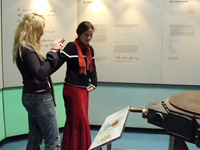October 2006 - December 2008
Funded by the Leibniz Association as part of the "Pact for Research and Innovation".
 This projects aimed to explore how media design tasks may foster learning activities
during and after museum visits. The typical behavior shown by student groups
visiting a museum is characterized by frequent but very brief engagement with
objects and a strong disregard for written information. These unfavorable conditions
for learning may be improved by assigning a collaborative media task in which
students are to first take pictures and then design a presentation for class.
It was expected that such a task helps to increase motivation as well as time
spent with individual objects and related information. According to the "genre
as cognitive strategy"-hypothesis by Klein (1999) and the "Knowledge
Telling vs. Transforming"-model by Bereiter and Scardamalia (1987), creating
a presentation may foster deeper processing of this information. Furthermore,
collaboration in pairs promotes learning activities such as explanation, argumentation
and elaboration, and will therefore contribute to better learning outcomes.
A first pilot study in december 2007 examined the outcomes of this media design
task with a variety of different school groups and exhibitions in a museum.
A second study focused on the role of the target format of the presentation,
taking into account genre (story-telling vs. instruction) and representational
features (relation of image to text box size).
This projects aimed to explore how media design tasks may foster learning activities
during and after museum visits. The typical behavior shown by student groups
visiting a museum is characterized by frequent but very brief engagement with
objects and a strong disregard for written information. These unfavorable conditions
for learning may be improved by assigning a collaborative media task in which
students are to first take pictures and then design a presentation for class.
It was expected that such a task helps to increase motivation as well as time
spent with individual objects and related information. According to the "genre
as cognitive strategy"-hypothesis by Klein (1999) and the "Knowledge
Telling vs. Transforming"-model by Bereiter and Scardamalia (1987), creating
a presentation may foster deeper processing of this information. Furthermore,
collaboration in pairs promotes learning activities such as explanation, argumentation
and elaboration, and will therefore contribute to better learning outcomes.
A first pilot study in december 2007 examined the outcomes of this media design
task with a variety of different school groups and exhibitions in a museum.
A second study focused on the role of the target format of the presentation,
taking into account genre (story-telling vs. instruction) and representational
features (relation of image to text box size).